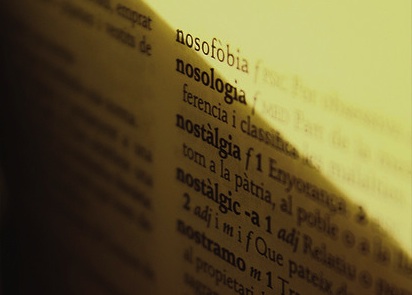Nostalgia brands – what to do if you spot one
Image courtesy of NuriaGuttierrez.
There are a group of brands that face a specific set of issues and that require specific actions to help them. All too often however, they are misdiagnosed and the wrong solutions are taken to market, solutions that at best do little more than simply waste budget and at worst contribute to long term brand damage.
I’d like to dwell a little on these brands, as I think they are incredibly common and I want to help you identify them diagnose them correctly and deliver the right approach to sort the little buggers out.
I am going to call these brands nostalgia brands. And classically they are those with bags of awareness, enormous heritage, huge amounts of affection and catastrophically declining sales. Indeed when commenting about her own brand, Cadbury’s Flake, one client told me that when asked about the brand in groups “everyone said they love it but no one had bought one in living memory”.
If you have a brand that everyone loves but no one is buying, you probably have a nostalgia brand on your hands.
Now, it is possible that the problem is one of product performance, that the product on offer while once market defining, is now substandard in some way. You could for instance say this about a brand like Pot Noodle that shares many of the characteristics of a nostalgia brand but at its heart no longer performs and is in desperate need of radical reformulation. However, while often idiosyncratic products, real nostalgia brands still perform for people. Their problem is a perceived lack of relevance to the lives of the people that should be buying them, in other words no clear role in those lives and no clear recognition by the brand on those lives and the way they have changed. What they therefore require is the rapid injection of relevance.
We could try and map the brandscape according to love and relevance.
Brands with high love and high relevance are those with powerful customer relationships. In the Saatchi & Saatchi world these would be called Lovemarks, in WPP probably Olympic brands. Think of Marmite here, part of the very stuff of British family life and passed from generation to generation but with bags of relevance to modern life – practically it performs a powerful role in weaning children onto more adult tastes and in delivering bags of good stuff, principally vitamin B. Emotionally marmite signifies the exchange of love between family members and by extension towards yourself when in later life you spread some on your morning toast. I think Persil, Andrex and Pampers possibly all come in this category too.
Brands with low love and high relevance could be called ‘just do it’ brands, those that get on with the job well and are part of the fabric of our lives but for whom there is little affection. Im going got stick my neck out here and say the standard bearer for this is Tesco – no one likes then but their buying, distribution and customer data management is so powerful that they have a clear role in many people’s lives (taking around one pound in every eight spent in the UK).
Let’s assume non of us us very interested in brands that no one loves and have no relevance – to steal a term from Boston Consulting, these are the dogs.
Which leaves us with the clutch of brands that have high levels of love an low relevance and these are our nostalgia brands. We have been working with one recently – Walls. People absolutely adore this brand, after all it has been on British tables and served to British families for well over 200 years. And yet fewer and fewer of those families were actually buying it. Its resurrection has involved improving product performance by extending the brand into pastry products like pasties and sausage rolls but it has also been about building back the relevance that the brand had progressively lost in recent decades.
So you have identified that you might have a nostalgia brand on your hands, what next? Well here is what you must not do:
1. Don’t listen to the reasons people will give in groups about why they aren’t buying the brand any more. These answers will be superficial and lead you up the garden path. People would say that the reason they didn’t buy Flake was because it is crumbly and messy to eat and yet it was equally crumbly and messy when the brand was selling like hot cakes. If you follow their advice you will deliver rational solutions to irrational problems and you won’t get anywhere. Walls was caught in this situation before we started looking after the brand a year ago, stuck in a differentiation trap with own label and rationally slogging it out over marginal differences in product quality, exemplified by the ‘two best bits’ campaign.
2. Don’t think that this is a problem that can be solved by another throw of the creative dice. Without a doubt your brand will require a significant lift in the quality of its creative output and this will be part of solving the problem. but the solution cannot start here, since the brand is in little need of more salience if this is not accompanied by a new role for the brand to play in people’s lives that will deliver relevance. If you are an agency you must not simply hand this problem to the creative department and if you are a client you cannot simply review the business into a creative hot shop and hope for the best. You will need some proper thinking done first.
3. Don’t take the lazy route out and fall back on the brand’s heritage. Rover was a nostalgia car brand in the UK and its equity was based on its heritage. Unfortunately so was the styling of its cars and the communication of the brand. Think of the brand’s heritage as a source of authenticity, incredibly powerful for the brand and one of the things that differentiates it from the mess of made up brands freshly minted in tedious NPD brainstorms. But do not be seduced into making it the heart of the brand’s communication with its customers.
So what’s the course of action?
Fundamental to solving brand problems like these is cracking how and in what way you are going to make the brand relevant to the audience’s lives. I’d say this is about ensuring the brand cares about something that real people care about. That it has both position on something important to people (regular readers will note that this is a recurring theme at adilterate) and a product promise that gives the brand credibility in holding this point of view. Walls believes that families that do stuff together stick together and as proper food Walls’ promise is that it fires up families to do stuff together. The key learning here is that relevance is not created executionally (though the body language of the brand can help enormously) it is created at the heart of the brand’s meaning to people – does it get me and my life?
Then you can let rip with the creative department because their job is then to find the most interesting way to map the position and promise onto people’s understanding of the brand and to create something that the brand, category and more importantly the consumer has never seen before. Not only is this powerful int its own right and a powerful multiplier for the media budget but it creates a moment in time for the consumer to re-evaluate what they think of the brand and change their shopping behaviour but also the start of an ongoing and far more positive conversation around the brand and its role in peoples’ lives.
Simple really.
But if there is one thing to take out of this it is that these nostalgia brands have to be spotted early and as a client or strategist you take the lead in ensuring the right diagnosis is made and solution implemented.
Discover more from
Subscribe to get the latest posts sent to your email.


great post.
i suppose what also makes a nostalgia brand nostalgic is that people think they will always be there. brands like cadbury’s are a little bit immortal. they last longer than you, longer than MTV, longer than anything pop culture. how sublime is that?
And sometimes in an effort to make things relevant, your nostalgic brands forget who they are, or who they belong to, and they fad themselves with the superfluousness of modern times when people are quite happy to have them as wallpaper. there for their grandkids and beyond. not sure what this translates to as a course for advertising, but i suppose immortal brands should keep very much true to themselves. not directly via heritage. certainly through what they already are in consumers hearts. and not go for a trendy advertising conceit. why do you love having me around is always a good question.
“Let’s assume none of us us very interested in brands that no one loves and have no relevance – to steal a term from Boston Consulting, these are the dogs.”
But couldn’t you, in some cases, find a relevance for these and from that relevance grow some love?
Interesting post that I mostly think is spot on.
That said though, nostalgia is a tricky one. Hovis moved away from it for a while to expand the brand, but then found a lot of success by going back to it.
Brands that last more than MTV, what a great definition!
Lurpak are doing it brilliantly at the moment.
@ Cat. Yes totally agree. Less of a nostalgia brand than others in the UK (more so in the North) but certainly one in Denmark where we have taken that strategy
oh that rare thing today. a genuinely interesting, insightful words from a planner
fascinating problem which I know all too well from working on Cadbury Dairy Milk
the challenge as you described cannot be tackled simply by dandy creative – it needs a root-canal-like strategic overhaul and re-invigoration – a mandate that most agencies don’t really have and most clients feel is ‘the business’ problem not the marketing.
Great post. The heritage point is really interesting. True, it’s lazy to just fall back on it, but it also can be quite a good place to look for stuff that you can use to inject relevance. If you pull apart the narrative there’s often something there that can be repackaged for a modern audience. Moreover you’ve got a nice story to tell about why the brand cares about this new thing it’s talking about.
good 2×2 (have you been on holiday and come back all refreshed ;-)
an extension would be how rapidly one can become a nostalgia brand these days (in my day it used to take decades…)
Nokia (hi love, lo relevance) have gone from mega-brand to the nostalgia draw in 3 years (in Western markets, for precision)
Root canal work required, almost certainly (but all I can see is tooth whitening)
the worst is when past hits of the brand start coming out as “retro”… thats when people consciously know that they think of the brand as “yeah, remember THAT one?”
we jus finished work on what we believe is the ‘strategic overhaul’ of a nostalgia brand… ur post rings like de ja vu richard, great writing… thanks a ton!